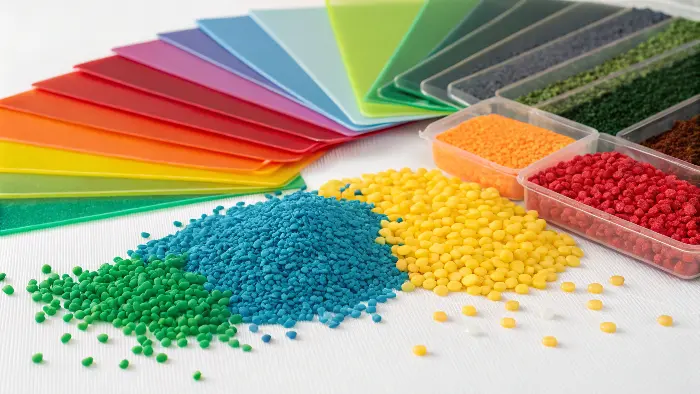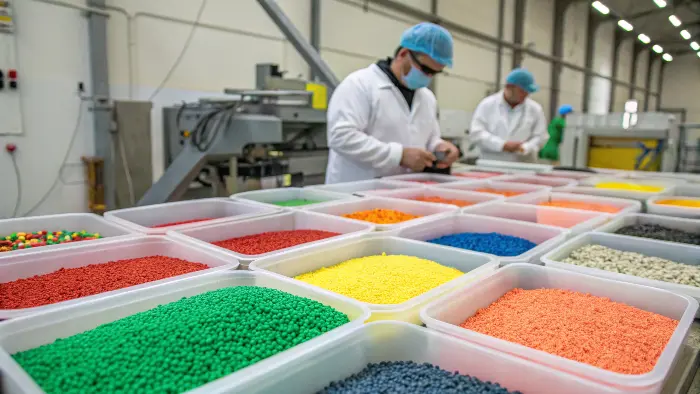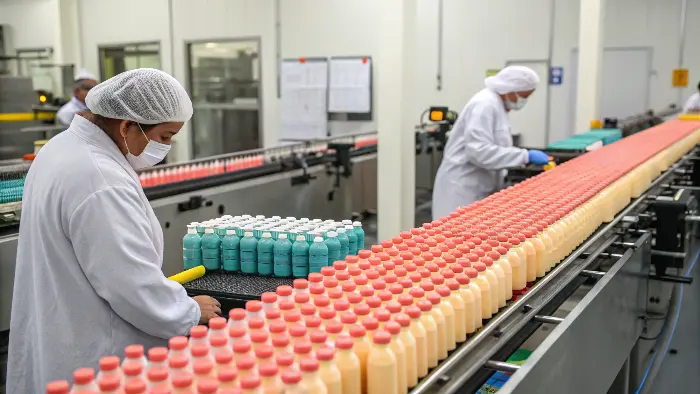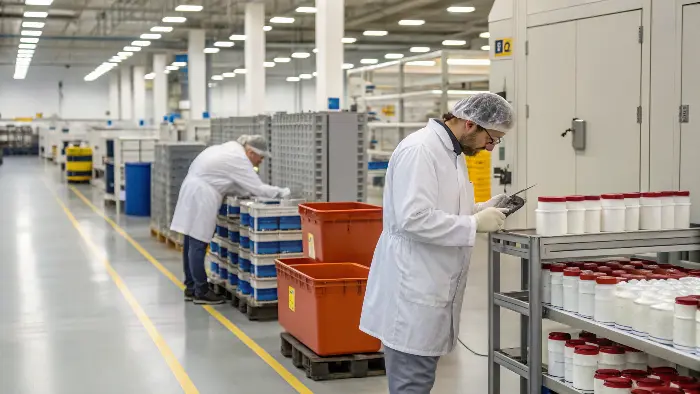Struggling to get that perfect, consistent color for your plastic products? It can be frustrating when the final product doesn’t match your design intent. Masterbatches offer a reliable solution to achieve vibrant, precise coloration every time.
Masterbatches are concentrated mixtures of pigments or additives encapsulated within a carrier resin. When added to raw polymer during manufacturing, they disperse evenly, allowing you to achieve your exact color specifications and bring your design vision for plastic products to life with consistency and quality.

Getting the color right is a big deal, isn’t it? It’s often the first thing a customer notices. If you’re wondering how this whole masterbatch thing actually works and why it’s so important, stick around. We’re about to dive into the nitty-gritty of making your plastic products pop with the perfect hue. I think you’ll find this pretty interesting!
What Exactly is a Masterbatch and How Does It Work in Plastics?
Ever wondered how plastic items get their specific, uniform colors? It’s not just paint! There’s a clever method involved. Understanding this process can really help you appreciate the precision behind colorful plastic products. It’s actually quite neat.
A masterbatch is a concentrated mix of pigments and/or additives encapsulated during a heat process into a carrier resin. This solid pellet is then blended with natural polymer during molding, ensuring even color distribution and specific properties in the final plastic part. It’s like a super-concentrated color shot for plastics!

So, let’s break this down a bit more. Think of a masterbatch as a highly potent colorant. Instead of dealing with messy, dusty pigments directly – which, trust me, can be a real pain and not great for your lungs – we use these neat little pellets. The "carrier resin" in the masterbatch is super important. It needs to be compatible with the main plastic you’re using for your product. For example, if you’re making a polypropylene (PP) part, your masterbatch carrier should ideally be PP or something very similar that gets along with it.
Here’s a simple way I explain the process to people:
- Creation: Pigments are mixed at a really high concentration with this carrier resin and maybe some other helpful additives. Then, this mix is extruded and chopped into small pellets. Easy peasy.
- Usage: A small, precisely measured amount of masterbatch (usually around 1-5% by weight – we call this the "let-down ratio" or LDR) is mixed with the bulk raw polymer. That’s the natural, uncolored plastic.
- Molding: This whole mixture then goes into an injection molding machine, or an extruder, or even a blow molder. The heat and mixing action inside the machine melts everything together, and voilà! The color from the masterbatch disperses uniformly throughout the molten plastic.
The result? A consistently colored part. It’s a much cleaner, more accurate, and often more economical way to color plastics compared to, say, trying to compound the entire batch of resin with raw pigments. I remember when we first started at CavityMold, getting this LDR just right felt like a bit of an art, but now it’s pure science for us. It’s all about precision!
Why is Choosing the Right Masterbatch So Crucial for Product Success?
Think color is just about looks? Oh, it’s so much more than that! The wrong color choice or poor quality can seriously impact how customers see your product, and not in a good way. Getting the masterbatch right is absolutely key to making a great first impression.
Choosing the right masterbatch is vital because it directly affects product aesthetics, brand perception, and even functional properties. A high-quality, correctly matched masterbatch ensures color consistency, durability, and compliance with safety standards, ultimately contributing to market success and customer satisfaction. It’s a small component with a big impact!

Okay, so why all the fuss about picking the right masterbatch? Well, first off, let’s talk brand identity. Think about famous brands – their colors are instantly recognizable, right? That specific red for a soda can, or a particular blue for a jewelry box. If your product color is off, even slightly, it can dilute your brand message or, worse, make it look like a cheap knock-off. I’ve seen it happen! A client once tried to cut costs with a cheaper masterbatch, and their signature "deep ocean blue" ended up looking more like "murky pond green" after a few months of UV exposure. Ouch. That was a tough lesson for them.
Then there’s product performance. Masterbatches don’t just carry color; they can also include all sorts of useful additives like:
- UV stabilizers (super important, as that "murky pond green" example showed!)
- Flame retardants
- Anti-static agents
- Processing aids
If your product needs to withstand sunlight, meet fire safety codes, or avoid attracting dust like a magnet, the masterbatch needs to be formulated for that. Choosing one based purely on color without considering these functional aspects is just asking for trouble. And finally, regulatory compliance. This is a biggie, especially for food packaging, toys, or medical devices. The pigments and additives in your masterbatch must be safe and meet specific regulations (like FDA rules in the US, or REACH in Europe). The right masterbatch supplier will make sure of this. So you see, it’s not just about a pretty color; it’s about a safe, reliable, and brand-aligned product. It’s serious stuff!
How Can You Ensure Color Consistency Across Different Production Batches?
You’ve nailed the perfect color for your product, fantastic! High fives all around! But now, how do you make sure every single item, batch after batch, month after month, looks exactly the same? Inconsistent colors can scream "low quality" to your customers, and nobody wants that.
To ensure color consistency across batches, rigorously control masterbatch quality, use precise dosing equipment, maintain consistent processing parameters (temperature, pressure, cycle time), and implement robust quality control checks with color measurement tools like spectrophotometers. A reliable masterbatch supplier is also absolutely key.

This is a big one for us at CavityMold, and for our clients like Alex, that project manager I mentioned. Color consistency is king! Imagine ordering a set of matching containers, and they all arrive in slightly different shades of blue. Not good, right? It just looks unprofessional. So, how do we tackle this challenge?
First, it all starts with the masterbatch itself. We always advise working with suppliers who have incredibly tight quality control on their pigment sourcing and masterbatch production. Each batch of masterbatch should come with a certificate of analysis (COA) – basically, a report card – confirming its color values.
Second, precise dosing. Remember that let-down ratio (LDR) I talked about earlier? It needs to be exact. We strongly recommend using automated dosing units that mix the masterbatch with the virgin polymer by weight, not volume, because it’s far more accurate. Even a tiny, tiny variation in the LDR can lead to a noticeable color shift. It’s all in the details!
Third, consistent processing conditions. This is where things can get a bit tricky if you’re not careful.
- Temperature: If the melt temperature in the molding machine fluctuates up and down, it can affect how the color disperses and even alter the pigment itself. Not ideal.
- Residence Time: How long the plastic stays molten in the barrel of the machine matters. Too short, not enough mixing. Too long, it might degrade.
- Screw Design & Speed: These affect the mixing efficiency. A poorly designed screw or the wrong speed won’t mix things properly.
We always tell our clients to establish a stable process window and then – this is the important part – stick to it! I remember a case years ago where a client’s parts were coming out different shades, and it turned out their machine operator was tweaking temperatures on the fly, thinking he was helping! Whoops.
Finally, quality control checks. We’re big fans of using spectrophotometers. These fancy gadgets measure the color of produced parts and compare them against a master standard. This gives us numerical data (Lab* values), taking all the guesswork out of color matching. Regular checks throughout a production run are essential. It’s a multi-faceted approach, sure, but totally worth it for that perfect, repeatable color.
What Are the Key Considerations When Selecting a Masterbatch Supplier?
Not all masterbatch suppliers are created equal – that’s for sure. Choosing the right partner can make a huge difference in your product quality and, honestly, your peace of mind. So, what should you look for to avoid headaches down the line?
When selecting a masterbatch supplier, consider their technical expertise, quality control processes, range of carriers and pigments, custom color matching capabilities, regulatory compliance knowledge, and customer support. A good supplier acts as a partner in your success, much like we aim to be at CavityMold for your mold needs.

Alright, this is where I can share some insights from our experience here at CavityMold. While we don’t make masterbatch ourselves, we work very closely with those who do, and we specify it for countless projects. So, if you’re in Alex’s shoes, our project manager persona, what should you be looking for in a masterbatch supplier?
- Technical Expertise & Support: This is number one for me. Can they help you troubleshoot issues if they pop up? Do they actually understand your specific polymer and application? A good supplier should be able to advise on the best carrier resin, pigment type, and LDR for your needs. They should ask you good questions too!
- Quality Control & Consistency: Ask them straight up about their QC procedures. Do they provide those COAs for each batch? How do they ensure consistency from one order to the next? Look for things like ISO certifications or similar quality management systems. It shows they’re serious.
- Custom Color Matching: If you have a very specific brand color (and most do!), you’ll need custom matching. How good are they at this? What’s their process? Can they match to a Pantone number, a physical sample you provide, or those Lab* values I mentioned? We often provide physical samples from previous successful runs for them to match – it’s very effective.
- Range of Products & Additives: Do they offer masterbatches for a wide variety of polymers? Can they incorporate those useful additives like UV stabilizers, flame retardants, etc., if you need them? A supplier who can be a bit of a one-stop-shop can be really convenient.
- Regulatory Compliance: This is huge, and I can’t stress it enough. Ensure they understand and comply with all the regulations relevant to your product and the market you’re selling in (e.g., FDA for food contact in the US, EU food contact regulations, RoHS, REACH). They should be able to provide all the necessary documentation without any fuss.
- Lead Times & Reliability: How quickly can they deliver, especially for custom colors? And more importantly, are they reliable? You don’t want your entire production line to grind to a halt because you’re out of masterbatch. That’s a nightmare scenario.
Think of your masterbatch supplier as an extension of your team. It really is a partnership. Just like our clients trust CavityMold for high-precision molds and expert advice, you need to have that same level of trust in your masterbatch supplier for consistent, quality color. It makes all the difference!
Are There Any Common Pitfalls to Avoid When Using Masterbatches for Plastic Coloration?
Using masterbatches seems pretty straightforward on the surface, but oh boy, there are a few common traps people fall into. Knowing these pitfalls can save you a ton of time, money, and a whole lot of frustration in your plastic production. Let’s uncover them, shall we?
Common pitfalls include using incompatible carrier resins, incorrect let-down ratios, poor pigment dispersion due to inadequate mixing or processing, ignoring environmental effects like UV degradation on color, and overlooking the impact of other additives on the final color or product properties. Careful planning and thorough testing are absolutely crucial.

Oh, absolutely, there are pitfalls! I’ve seen a fair few in my time, believe me. It’s not always smooth sailing, especially if you’re new to this whole masterbatch game or, dare I say, trying to cut a few too many corners. Here are some of the big ones to watch out for:
- Carrier Incompatibility: This is a classic mistake. Using a masterbatch with a carrier resin that just doesn’t play well with your main polymer. For example, trying to use a PE-based (polyethylene) masterbatch in a PC (polycarbonate) part. It can lead to all sorts of problems: delamination (layers peeling apart), poor mechanical properties (the part breaks easily), surface defects – a real mess. Always, always check compatibility! It’s like trying to mix oil and water sometimes.
- Incorrect Let-Down Ratio (LDR): Too little masterbatch, and your color will be weak, washed out, or inconsistent. Too much, and you’re basically just wasting money. Plus, an excessive amount of masterbatch can sometimes negatively affect the plastic’s properties or cause processing issues like screw slippage in the machine. Precision here is really key.
- Poor Dispersion: This is when you see ugly streaks, specks, or swirls of color in your final product instead of a nice, uniform hue. This can be due to a few things:
- The masterbatch itself (maybe it’s poor quality or not designed for good dispersion).
- Inadequate mixing in the molding machine (e.g., wrong screw design for the material, insufficient back pressure, or too short a cycle time not allowing enough mixing).
- Processing temperatures being too low, so the masterbatch doesn’t melt and flow properly.
I remember one project where we were getting terrible streaking. After a lot of head-scratching, it turned out the heating bands on one zone of the injection molder were faulty! Took a while to diagnose that one, let me tell you.
- Ignoring Environmental Factors: This is a biggie. Choosing a pigment that looks great initially but fades quickly in sunlight for an outdoor product. Or selecting a colorant that leaches out when it comes into contact with certain chemicals. You have to consider the end-use environment of your product.
- Overlooking Additive Interactions: Sometimes, the pigments in the masterbatch can interact with other additives already in the polymer (or vice-versa), affecting the final color or even the material’s performance. For instance, some types of flame retardants can cause noticeable color shifts. It’s a chemical cocktail in there!
- Not Testing Thoroughly: My final piece of advice: always, always run trials with a new masterbatch or whenever you’re making significant changes to your process. Make actual parts and test them under real-world conditions if possible. Don’t just rely on those little color plaques the supplier might send.
Avoiding these pitfalls often comes down to good, clear communication with your masterbatch supplier, careful process control on your factory floor, and thorough testing. It’s a bit like baking a cake – the right ingredients, the right recipe, and the right technique make all the difference! 😉
Conclusion
So, masterbatches are pretty much your secret weapon for achieving that perfect, eye-catching color in your plastic products. Get the right one, use it correctly, and your products will truly shine. It’s all about precision, quality, and fostering a good partnership with your suppliers!
